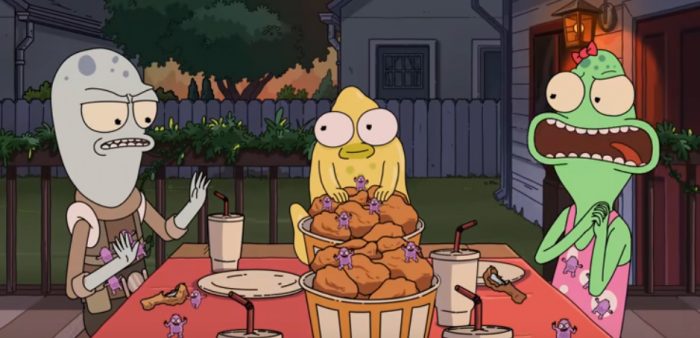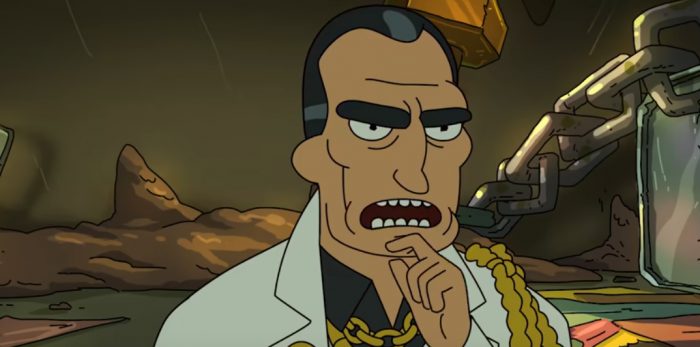'Solar Opposites' Review: The Lunacy Of 'Rick And Morty' Meets The Classic Family Sitcom For Deranged Hilarity
Rick and Morty is known for insane space adventures that take the titular uncle and nephew duo (and sometimes the rest of their depressing suburban family) into grotesque, weird, violent, and disturbing planets, galaxies, alternate timelines, and various other sci-fi landscapes. You might expect more of the same from the new Hulu animated series Solar Opposites since it hails from from Rick and Morty co-creator Justin Roiland and series writer Mike McMahan, especially since it follows a "family" of aliens stranded on Earth who are forced to deal with the dredges of humanity and suburban life. Even though the animation style, character design and sense of humor falls in line with Rick and Morty, this sidesplitting, raucously hilarious show brings something different to the table, delivering a quality, clever comedy that is somehow simultaneously darkly deranged and charmingly lighthearted.Solar Opposites follows a team of four aliens who were forced to evacuate their home world Shlorp and sent to find a new planet inhabit. There's the leader Korvo, voiced by Justin Roiland, who is basically doing his Rick voice with less grit, a bit more enunciation, and no drunken burping. Korvo is mostly focused on the mission and repairing the ship they crashed into the roof of their new suburban home, though he frequently gets distracted by the antics of the pop culture obsessed Terry (Thomas Middleditch), who is often rambling off endless movie and TV references, chomping on off-brand junk food, and wearing goofy novelty t-shirts. Sometimes they're like brothers, other times they're like gay dads, but their fast-talking personalities always make for some of the funniest exchanges of the show, whether it's in frustration or celebration.
There's Yumyulack (Sean Giambrone of The Goldbergs) and Jesse (Mary Mack) who are the replicants, younger aliens who aren't actually the children of Terry and Korvo, but are forced to live a teenage life going to high school, giving us the brother/sister dynamic that we're seen countless times before. Yumyulack is interested in studying the humans in an ethically questionable manner and frequently finds himself frustrated with them. Meanwhile, Jessie is mostly into all the fun stuff that comes with being a teenage girl. They have to deal with things like teachers who hate them simply because they're aliens, a special kind of puberty, and a concerning experiment, but we'll get to that later.

So what are these aliens doing besides trying to live on Earth? Well, they have to wait around until an adorable and strange yellow glob-like supercomputer known as The Pupa evolves to the point where it can terraform Earth and make it habitable for the rest of the Shlorp-ians spread across the universe. Funnily enough, this plot point isn't even mentioned until the very end of the first episode. That leaves them to their devices as they live suburban life as best they can. Thankfully, Solar Opposites spares us the process of them acclimating to life on Earth, learning about humans, or trying to hide themselves. That's been done countless times before, so instead, the show introduces us to these aliens after they've been on Earth for about a year. That gives them plenty of time to be extremely well-versed in pop culture to allow for maximum references. But perhaps for a funnier reason, it allows humans to already be used to their presence on the planet, which means they're either treating the aliens like any other person, for better or worse, or they're extremely inconvenienced by them and all their sci-fi antics.
In some ways, Solar Opposites is more deranged than Rick and Morty. While the latter has plenty of nasty violence replete with gnarly alien deaths by blades, explosions, laser blasts, and various sci-fi weaponry, the violence in Solar Opposites feels more extreme, perhaps because it's so nonchalant in its execution and typically involves humans being recklessly killed without any real consequences for our main characters. Rick and Morty kills tons of aliens and occasionally humans, but at least they often have to set things right in the versions of Earth that haven't gone sideways in strange sci-fi ways. But in the first two minutes of the season premiere alone, the Great Wall of China and Big Ben are significantly damaged and a tidal wave is created elsewhere when Korvo drives a drill vehicle to the core of the Earth in an effort. Throughout the rest of the season, humans are killed in a variety of ways, whether it's by the merged flesh matrixes of two artificially created alien characters from a TV show that resembles ALF mixed with Mr. Wizard or by lava that freezes people and spreads across their suburb. Again, this all happens rather casually without any real consequences for the aliens.
Don't get me wrong, it's extremely funny, but that feeling of it being much more unhinged lingers. Maybe it's because despite all the violence the show inflicts upon humans, the core of the show still feels lighthearted thanks to the playful dynamic of the aliens lifestyle, which, despite the rampant human death, is far less confrontational and depressing than that of the family at the center of Rick and Morty.

However, all of the various deaths and crimes committed against humans are nothing compared to a certain experiment being conducted by Yumyulack in the bedroom he shares with Jesse. One of the walls in the bedroom can best be described as a massive multi-level hamster habitat. But it's not hamsters living in this structure. It's shrunken down humans who are mostly living off candy and whatever small items get tossed into their new environment. The humans have been there long enough that there's an entire post-apocalyptic society which already has a leader called The Duke (voiced by Alfred Molina, seen above) wielding power and trying to keep another faction of humans from sparking a revolution. Even though it hasn't been teased in the marketing materials, this serves as a secondary plot throughout the entire first season, becomes more significant as the story continues, and it pays off in a big way that is extremely rewarding on a number of levels. We won't dare spoil that here, because it's one of the show's finer points. But suffice it to say, there's a lot more happening here than an alien sitcom, and this subplot on the show is a big part of what makes it brilliant and original.
One last little touch is the subtle presence of The Pupa. While the little yellow guy occasionally has a small side adventure of his own, often finding him being mischievous and destructive in the name of something silly and insignificant, the best of The Pupa are little gags that you have to keep your eyes peeled for. He's often lingering in the background and doing something that doesn't relate to the main plot of the show. They're typically silent sight gags and oddly cute moments, making him like a gross Baby Yoda, and I hope there's a cuddly version of him made available as a plush sometime down the road.
Rick and Morty is largely considered to be the best and most consistently funny animated comedy for adults on the air today. But Solar Opposites can certainly give it a run for its money. The show has more of a serial arc for our characters, and the mix of raunchy sci-fi comedy with the genuine heart of classic sitcoms makes for something that's familiar enough to be accessible, but weird enough to stand out. Plus, Hulu seems to be a lot less restrictive when it comes to profanity and sexual content, which allows Justin Roiland and Mike McMahan to be a little more bold. It's more than enough to make Solar Opposites stand on its own two feet. This series will have you laughing hysterically enough to pause the show for an extra breath, and there are a handful of shocking twists that make it a must-see. Binge the series immediately when it hits Hulu on May 8, and thank me later.
